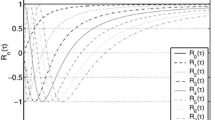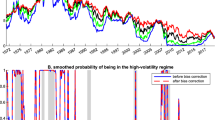Abstract
We show that the recently developed non-parametric procedure for fitting the term structure of interest rates developed by Linton, Mammen, Nielsen, and Tanggaard (J Econ 105(1):185–223, 2001) overall performs notably better than the highly flexible McCulloch (J Finon 30:811–830, 1975) cubic spline and Fama and Bliss (Am Econ Rev 77:680–692, 1987) bootstrap methods. However, if interest is limited to the Treasury-bill region alone then the Fama–Bliss method demonstrates superior performance. We further show, via simulation, that using the estimated short rate from the Linton–Mammen–Nielsen–Tanggaard procedure as a proxy for the short rate has higher precision then the commonly used proxies of the one and three month Treasury-bill rates. It is demonstrated that this precision is important when using proxies to estimate the stochastic process governing the evolution of the short rate
Similar content being viewed by others
References
Aït-Sahalia Y (1996a) Non-parametric pricing of interest rate derivative securities. Econometrica 64(3):527–560
Aït-Sahalia Y (1996b) Testing continuous-time models of the spot interest rate. Rev Financ Stud 9:385–426
Amihud Y, Mendelsohn H (1991) Liquidity, maturity and the yields on US treasury securities. J Finan 46:1411–1425
Bandi F, Phillips P (2003) Fully nonparametric estimation of scalar diffusion models. Econometrica 71:241–283
Bliss R (1997) Testing term structure estimation methods. Adv Futures Options Res 9:197–231
Chambers DR, Carleton WT, Waldman DW (1984) A new approach to estimation of the term structure of interest rates. J Finan Quant Anal 19:233–269
Chan KC, Karolyi GA, Longstaff FA, Sanders AB (1992) An empirical comparison of alternative models of the short-term interest rate. J Finan 47:1209–1227
Chapman DA, Pearson ND (2000) Is the short rate drift actually nonlinear?. J Finan 55:355–388
Chapman DA, Long JB, Pearson ND (1999) Using proxies for the short rate: when are three months like an instant?. Rev Financ Stud 12(4):763–806
Chen R, Scott L (1993) Maximum likelihood estimation for a multifactor equilibrium model of the term structure of interest rates. J Fixed Income 4:14–31
Conley T, Hansen PL, Luttmer E, Scheinkman J (1997) Short-Term Interest rate as subordinated diffusion. Rev Financ Stud 10, 10(3):525–577
Cox J, Ingersol J, Ross S (1985) A theory of the term structure of interest rates. Econometrica 53:385–406
Duffee D (1996) Idisyncratic variation of treasury bill yields. J Finance 51:527–551
Fama E, Bliss R (1987) The information in long-maturity forward rates. Am Econ Rev 77:680–692
Fisher M, Nychka D, Zervos D (1995) Fitting the term structure of interest rates with smoothing splines. Working paper 95-1, Finance and economics discussion series, Federal Reserve Board
Heath D, Jarrow R, Morton A (1992) Bond pricing and the term structure of interest rates: a new methodology for contingent claims valuation. Econometrica 60:77–105
Hull J, White A (1990) Pricing interest rate derivative securities. Rev Financ Stud 3(4):573–592
Jiang G, Knight J (1997) A nonparametric approach to the estimation of diffusion processes, with an application to a short term interest rate model. Econ Theory 13:616–645
Linton O, Mammen E, Nielsen J, Tanggaard C (2001) Estimating yield curves by kernel smoothing methods. J Econ 105(1):185–223
McCulloch JH (1971) Measuring the term structure of interest rates. J Bus 44:19–31
McCulloch JH (1975) The tax-adjusted yield curve. J Finan 30:811–830
Nelson CR, Siegel AF (1987) Parsimonious modeling of yield curves. J Bus 60:473–489
Sarig O, Warga A (1989) Bond price data and bond market liquidity. J Financ Quant Anal 24:367–378
Stanton R (1997) A nonparametric model of term structure dynamics and the market price of interest rate risk. J Finan 52:1973–2002
Svensson LEO (1994) Estimating and interpreting forward interest rates: Sweden 1992/4. IMF working paper no 94/114
Vasicek OA, Fong HG (1982) Term structure modelling using exponential splines. J Finan 37:339–348
Vasicek O (1977) An equilibrium characterization of the term structure. J Financ Econo 5:177–188
Waggoner D (1997) Spline method for extracting interest rate curves from coupon-bond prices. Working paper 97–10, Federal Reserve Bank of Atlanta, USA
Author information
Authors and Affiliations
Corresponding author
Rights and permissions
About this article
Cite this article
Jeffrey, A., Linton, O. & Nguyen, T. Flexible Term Structure Estimation: Which Method is Preferred?. Metrika 63, 99–122 (2006). https://doi.org/10.1007/s00184-005-0017-8
Published:
Issue Date:
DOI: https://doi.org/10.1007/s00184-005-0017-8




